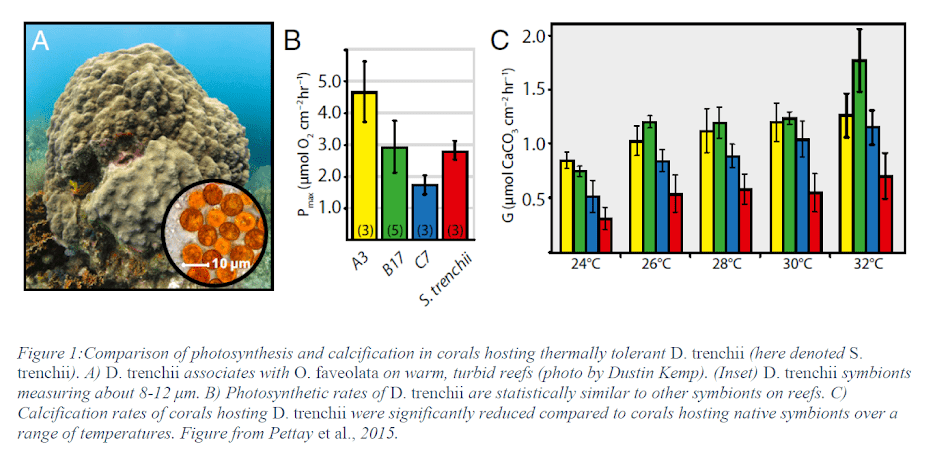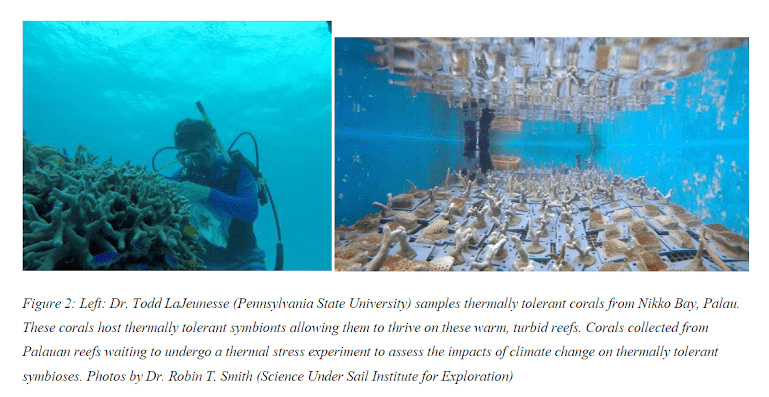Written by Tim Bateman
Corals and other reef-dwelling cnidarians (animals with stinging cells), such as anemones, host a diverse array of photosynthetic algae of the family Symbiodiniaceae, forming a mutualistic symbiosis. The symbiosis between corals and their photosynthetic algae creates the base of the ecosystem on reefs worldwide as symbionts are responsible for providing up to 100% of the energy that corals require to survive. This symbiosis, however, is sensitive to thermal perturbations and under increasing threat due to climate change. When thermally stressed, corals bleach, resulting in the loss of their photosynthetic symbionts and pigments, depriving the host of a vital food source and often resulting in the death of the coral. Climate change stressors elicit different responses from corals depending on the host+symbiont pairing, allowing some corals to persist and thrive as the oceans warm. Specifically, studies have identified species of thermally tolerant symbionts that can increase the bleaching threshold of corals by 1-2°C. In some cases, corals pay for this increase in symbiont resilience by incurring metabolic tradeoffs and receiving less fixed sugar from their symbionts. Some research has highlighted how thermally tolerant microbes form a more parasitic relationship to maintain function at higher temperatures, but this is not always the case and some reefs around the world harbor corals with thermally tolerant without apparent fitness tradeoffs.

In the Caribbean, corals hosting the thermally tolerant symbiont Durusdinium trenchii display increased bleaching resistance to elevated temperature, but at a cost. On Caribbean reefs, the framework massive coral Orbicella faveolata commonly hosts either D. trenchii or Cladocopium spp. A study comparing O. Faveolata hosting these two symbionts found rates of photosynthesis between the two were similar, but corals hosting D. trenchii had calcification rates half that of corals hosting C. spp (Figure 1). This would suggest that D. trenchii increases thermal tolerance at the cost of transferring less fixed carbon to the host coral; thus, these corals have less energy to invest in calcification. As it turns out, the population genetic data suggest that this may be because the relationship between D. trenchii and Caribbean hosts is maladapted. The low genetic diversity indicates that human activity introduced D. trenchii to the Caribbean in recent decades and so has not had a chance to coevolve with coral hosts. D trenchii is often found in hosts following environmental disturbance when background populations can proliferate and displace native, stressed symbionts. The persistence of symbioses between D. trenchii and Caribbean hosts could allow corals to survive periods of thermal stress but with significant tradeoffs. Maladapted host+symbiont combinations will likely not be effective reef-builders and will negatively affect reef accretion if they persist long term in the Caribbean.
Durusdinium might be considered an invader in the Caribbean, but there are reefs in the Pacific and the Red Sea, where these symbionts have coevolved with hosts since the Pleistocene epoch and form beneficial symbioses without evidence of significant tradeoffs. D. trenchii is commonly found on warm, turbid reefs, allowing corals to inhabit environments that would typically be considered suboptimal and stressful for corals. For example, Hume et al. 2020 surveyed six reef sites across the Thuwal reef system in the Red Sea to investigate host-symbiont associations. These reefs consistently experience temperatures upwards of 32°C and extreme temperature fluctuations, and a large percentage of corals hosted the thermally tolerant D. trenchii.
D. trenchii and D. glynnii are also prevalent symbionts residing in corals in the extreme environment of Nikko Bay, Palau. Nikko Bay is a shallow, turbid embayment that is characterized by temperatures 1-2°C warmer than neighboring offshore reefs. Corals from Nikko Bay displayed greater bleaching resistance and recovery during the 1998 and 2010 bleaching events compared to corals from offshore reefs. Similarly, corals from Nikko Bay hosting D. trenchii exhibited a consistently muted bleaching compared to the same coral species from offshore reefs hosting Cladocopium spp when exposed to laboratory-induced thermal stress. This same study found that the host had a significant impact on the response of D. trenchii to elevated temperature, highlighting the variability of thermal tolerance mechanisms across this species. Research in Palau is currently attempting to assess the effects of different biotic factors on the performance of thermally tolerant symbioses and how these relationships will respond to climate change (Figure 2).

Thermally tolerant coral symbionts can allow corals to thrive in marginal environments and resist bleaching under stressful conditions that are becoming more common due to anthropogenic climate change. In the Caribbean, D. trenchii is a recent microbial invader that has formed maladapted symbioses with corals and can have a detrimental effect on calcification if they can displace the native symbionts. This can allow corals to survive bleaching events, but with significant physiological tradeoffs. Some recent work has focused on highlighting D. trenchii and thermally tolerant symbionts as more parasitic due to these maladapted symbioses, but this is not the whole story. In the Pacific and the Red Sea, thermally tolerant symbionts have coevolved with hosts to form beneficial symbioses that are not only thermally resilient but also function as well at ambient temperatures when compared to neighboring corals hosting less tolerant symbionts. These symbionts could provide insight into the mechanisms that delineate tolerant and sensitive species and show scientists how symbionts could help corals persist in the future. Successfully harnessing the understanding of thermal tolerance mechanisms and the benefits versus tradeoffs of thermally tolerant symbioses within coral populations will assist in the management and conservation of resilient reefs.
References:
Hoadley, K. D., Lewis, A. M., Wham, D. C., Pettay, D. T., Grasso, C., Smith, R., Kemp, D. W., LaJeunesse, T. C. and Warner, M. E. (2019). Host-symbiont combinations dictate the photo-physiological response of reef-building corals to thermal stress. Scientific Reports 9, 15.
Hume, B. C. C., Mejia-Restrepo, A., Voolstra, C. R. and Berumen, M. L. (2020). Fine-scale delineation of Symbiodiniaceae genotypes on a previously bleached central Red Sea reef system demonstrates a prevalence of coral host-specific associations. Coral Reefs, 19.
Pettay, D. T., Wham, D. C., Smith, R. T., Iglesias-Prieto, R. and LaJeunesse, T. C. (2015). Microbial invasion of the Caribbean by an Indo-Pacific coral zooxanthella. Proceedings of the National Academy of Sciences of the United States of America 112, 7513-7518.
